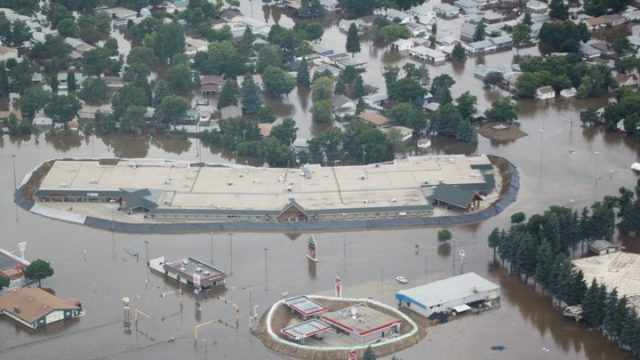Senate Pushes Flood Insurance Program A Little Closer To Collapse

The Senate today passed a bill to delay rate hikes in the federal flood insurance program. Both North Dakota Senators – John Hoeven and Heidi Heitkamp – were yes votes.
Meanwhile, that program is $26 billion in debt, thanks to the fact that it subsidizes low flood insurance premiums for a lot of people who have built in areas that are high risk for flooding. Some argue that the rate hikes are the result of poor flood mapping by FEMA, which is to say that they’re naming areas as high risk for flooding that really aren’t, but the debt speaks for itself.
There wouldn’t be any debt if the flood insurance premiums were an accurate reflection of flood risk.
The National Flood Insurance Program was created in response to the private sector mostly dropping flood insurance services. It wasn’t profitable to offer, and so when a flood would hit an area it was left to the government to bail everybody out. The NFIP was created as an alternative to bailouts, but as you can see from the debt it hasn’t worked much better. Far from controlling costs, the program is basically subsidizing the development of property in high-risk areas.
Wikipedia has a good summary of the history of nationalized flood insurance:
Before 1950 flood insurance was part of the standard homeowner’s insurance policy. During the 1950s increasingly high correlation of losses by holders of flood policies of the same company caused many insurance companies to begin excluding flood coverage from standard insurance policies, selling flood insurance separately. Over time, insurance premiums collected were insufficient in covering payouts after major flooding events. In the 1960s flood insurance became completely unprofitable and private companies no longer offered flood insurance policies. This meant that the costs of floods were borne by property owners, many of which could not afford such high disaster costs. The government provided public disaster aid to affected property owners. In 1968, the National Flood Insurance Act established the National Flood Insurance Program (NFIP), which allows property owners to purchase insurance from the U.S. government that covers certain losses from flooding. The intended purpose of the program was to reduce the overall costs of floods by incentivizing flood risk management and to pool flood risks nationally to lessen the blow to individuals hit by major floods. This insurance is not set by the market risk valuation. It is less expensive than the private insurance company rate would be. This is accomplished either by the program running a deficit and borrowing money or by subsidies from the national government. Either way, the property owners with NFIP policies are receiving government subsidies to live in areas with high flood risk.
So the government created this mess. In 2012 Biggert-Waters Flood Insurance Reform Act was passed to try and forced flood insurance premiums to reflect flood risk (higher risk = higher premiums, just like with normal insurance), and the implementation of that law is what the Senate delayed today.
And, to be fair, there are a lot of people caught in the middle on this thing. The government has created an enormous market distortion, and we’re left with a choice between a painful correction to get flood insurance premiums back in line with flood risks or a flood insurance program that is going to continue running billions of dollars in the red.




